The decoy effect can increase product sales by up to 20%. It’s a psychological tactic where an extra, less appealing option makes another choice look better. Businesses like Netflix, Apple, and The Economist use this to guide customers toward higher-value purchases.
Key Takeaways:
- What it is: The decoy effect influences decisions by adding a "worse" option to highlight the value of a target choice.
- How it works: People compare options instead of evaluating them individually, making the target option stand out.
- Examples:
- The Economist's subscription pricing uses a decoy to drive bundle sales.
- Streaming services use mid-tier plans as decoys to sell premium options.
- Application: Position decoys close in price but lower in features to nudge customers toward the desired choice.
- Ethics: Transparency is key - focus on real value to maintain trust.
By understanding and applying the decoy effect responsibly, businesses can boost conversions while keeping customer satisfaction intact.
What is The Decoy Effect?
What is the Decoy Effect?
The decoy effect is a psychological tactic that influences how people make choices by introducing an extra option. This additional option, strategically placed, can steer consumers toward a specific choice.
Defining the Decoy Effect
The decoy effect happens when a less attractive option is added to highlight the appeal of another. People tend to compare options rather than evaluate them individually, and this bias can be used to guide decisions.
Take The Economist's subscription strategy as an example. They offered three options:
| Subscription Type | Price | Features |
|---|---|---|
| Digital Only | $59 | Online access |
| Print Only | $125 | Print magazine |
| Print + Digital | $125 | Print magazine + Online access |
The $125 "Print Only" option acted as a decoy. It made the $125 "Print + Digital" bundle seem like a much better deal, boosting sales of the bundle.
How Asymmetric Comparisons Work
Asymmetric dominance happens when the decoy is clearly worse than the target option but still comparable to others. This makes the target option stand out as the best choice.
Here’s how businesses use this:
- Price the decoy close to the target option.
- Ensure the decoy offers fewer benefits than the target.
- Make the differences clear enough for customers to notice.
For instance, movie theaters use this with popcorn pricing. A medium-sized popcorn, priced just below the large, serves as a decoy, making the large seem like the smarter choice.
Psychology Behind the Decoy Effect
The decoy effect taps into how we think and make decisions, especially when we're comparing options. In marketing, understanding this can help businesses design offers that naturally guide customers toward specific choices.
How Context Shapes Choices
The way options are presented influences how we decide. Instead of judging each option on its own, we instinctively compare them. This is why the decoy effect works so well in marketing - it shifts how we see value.
For example, pricing strategies often take advantage of this. When given several options, people tend to focus on the differences between them rather than evaluating each one individually. Research even shows the decoy effect can sway up to 85-95% of buying decisions.
A good example? Streaming services. They use tiered pricing to nudge customers toward mid-tier or premium plans. Features, prices, and other measurable factors become the key points people use to decide, making the decoy effect a powerful tool.
Understanding Consumer Perception
What people see as "valuable" changes based on the options around them. This is especially true when they're unsure of what they want, which often happens with complex purchases.
Decoys simplify this process. By offering a less appealing option, businesses can make the desired choice stand out. This strategy has been shown to increase product sales by 20%, as it plays into our brain's preference for easier comparisons.
Ultimately, value is all about context - how one product stacks up against others. Marketers can use this to subtly guide customers toward the option they want them to pick.
Using the Decoy Effect in Marketing Funnels
Decoys in Subscription Pricing
Subscription services often use the decoy effect to nudge customers toward a specific choice. This tactic leverages the concept of asymmetric dominance, commonly through a three-tier pricing model.
Take streaming platforms, for example. They typically offer basic, standard, and premium plans. The standard plan often acts as a decoy, making the premium plan seem like a better deal. Meanwhile, the basic plan remains available for customers looking for the lowest price.
Boosting Upselling Strategies
E-commerce and software companies often use the decoy effect to encourage higher-value purchases. For instance, a software company might price a standard version at $199 with basic features and a premium version at $209 with far more capabilities. The minimal price difference makes the standard version a decoy, pushing customers toward the premium option.
How to Create Effective Decoys
Positioning a decoy correctly is key. It should be close in price and features to the target option but intentionally less appealing. Research shows this approach can significantly increase interest in the desired product.
Here’s how to do it:
- Limit choices: Offer three options to avoid overwhelming customers.
- Strategic pricing: Place the decoy price near the target option.
- Feature comparison: Highlight some strengths in the decoy, but ensure it’s less desirable overall.
While using decoy pricing, it’s important to remain transparent. Thoughtful application of these tactics can subtly steer customer decisions without compromising trust.
sbb-itb-a84ebc4
Ethics of Using the Decoy Effect
The decoy effect can influence decisions, but using it responsibly is key to keeping customer trust intact. While it can guide purchasing choices, ethical use means presenting options transparently and empowering customers to make informed decisions. Done right, the decoy effect can improve the customer experience rather than harm your reputation.
Balancing Sales and Customer Trust
Using the decoy effect effectively involves focusing on real value instead of manipulating customers. Businesses can achieve this by:
- Clearly comparing features across all options
- Keeping pricing formats consistent
- Offering easy-to-use comparison tools
- Making all relevant information readily available
Staying Transparent
To apply the decoy effect responsibly, companies should:
1. Regularly Review Practices
Gather customer feedback and audit pricing strategies to ensure they guide decisions without being misleading.
2. Measure More Than Sales
Look beyond conversion rates. Track metrics like customer retention and satisfaction to confirm the strategy strengthens relationships.
3. Focus on Real Value
Design options that emphasize true differences in value rather than creating false comparisons.
When used to highlight genuine value while preserving transparency, the decoy effect can help businesses achieve their goals without eroding trust. This balance ensures long-term success and customer loyalty.
Resources for Building Better Marketing Funnels
Using the decoy effect in marketing funnels requires the right tools and resources to fine-tune pricing strategies and influence customer choices.
The Marketing Funnels Directory offers a collection of tools, analytics, and educational materials specifically designed to improve funnel performance. This includes strategies like the decoy effect, which can help create pricing models that align with customer behavior and boost conversions.
Some of the directory’s offerings include pricing tools, analytics platforms, A/B testing software, and educational content. To effectively apply the decoy effect, focus on tools that:
- Track customer behavior to reveal decision-making patterns
- Experiment with different pricing setups
- Streamline customer journeys to encourage specific choices
For businesses exploring psychological pricing for the first time, this directory also provides guidance on how to use the decoy effect responsibly. With these resources, businesses can create ethical and effective marketing funnels tailored to their goals.
Conclusion: Using the Decoy Effect in Marketing
The decoy effect can be a game-changer for improving marketing funnel performance when applied carefully. Studies reveal that well-placed decoys can boost demand for target products by up to 20%, showcasing their influence on consumer choices.
Here’s how to apply the decoy effect effectively:
- Position decoys strategically: Place them slightly less appealing than the target option in value but close in price.
- Test thoroughly: Use A/B testing to explore different decoy setups and measure their impact.
- Track outcomes: Keep an eye on both sales figures and customer satisfaction to ensure the approach works as intended.
A great example of this in action is The Economist's subscription pricing model, which nudges customers toward higher-value options through clever pricing strategies.
For businesses aiming to refine their marketing funnels, a data-focused approach is key:
- Set clear benchmarks before introducing decoys.
- Experiment with various decoy placements and configurations.
- Monitor both short-term conversions and long-term customer loyalty.
If you're looking for tools to execute these strategies, the Marketing Funnels Directory provides resources to help you design effective psychological pricing models while maintaining ethical standards.
Keep in mind that success depends on continuous testing and adjustments. Regularly analyzing customer behavior and purchase trends will help fine-tune your decoy tactics for better results without compromising trust.
FAQs
What is an example of a decoy strategy?
A classic example of the decoy effect is The Economist's subscription pricing. As mentioned in the "Defining the Decoy Effect" section, they used a cleverly designed pricing structure to guide customers toward their premium package. The decoy option made the higher-priced choice appear more appealing.
How can businesses measure decoy effect success?
To evaluate the impact of a decoy strategy, businesses should monitor both immediate and long-term results. Look for these key metrics:
- Higher conversion rates (typically 15-20%)
- Increased average order value (around 10-25%)
- Shorter decision-making times for customers
- Stable or improved customer satisfaction levels
Are there ethical concerns with decoy pricing?
Yes, decoy pricing can raise ethical questions. To use it responsibly, businesses should stay transparent and ensure all options provide real value. A good example is Apple. They price older iPhone models slightly lower than the latest ones. This not only highlights the advanced features of the new models but also offers a legitimate, budget-friendly choice.
How do you create effective decoy options?
Crafting a strong decoy involves a few key principles, as outlined in the "Using the Decoy Effect in Marketing Funnels" section:
- Price proximity: The decoy’s price should be about 10-15% different from the target option.
- Feature disparity: The decoy should clearly offer fewer benefits compared to the target.
- Believability: The decoy must still seem like a reasonable choice on its own.


